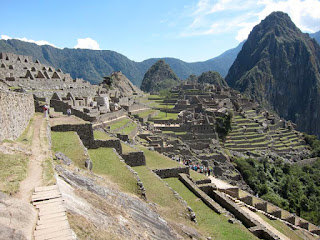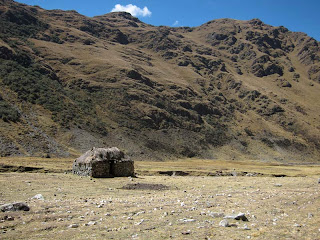I've just come back to Lima from a quick tour in central Cusco Department, Peru. Short on captions, here's a quick photo rundown of the trip. First, the obligatory photo from the ruins of Machu Picchu.
This lizard is very common on the ruins. Last year I narrowed it down to either Stenocercus ochoai or S. crassicaudatus, but I haven't nailed it down yet. Anyone out there know?
Down in the valley below the ruins.
An amazing leaf gall. Caused by a wasp or fly that lays its eggs on the leaf. The eggs secrete a chemical that the plant interprets as a hormone that makes it grow these "tumors" which proved shelter and food for the tiny larve.
My friend Michael Harvey thinks this tiny lizard is Proctoporus unsaacae, though he admits that may be an outdated name. Lizard taxonomy in the tropics is a knot proving very hard to untangle. There are many undescribed species out there to make it even more complicated.
I though this plant was most likely a Phyllanthus species.
Torrent Duck
White-capped Dipper
The highest ridge in the Urubamba Mountains, topped by Nevado Veronica at 19,100 feet.
The northern (Amazonian) slope has some nice cloud forest, home to many hummingbirds, such as this Purple-backed Thornbill.
A giant Fuchsia, surely a favorite plant for the Sword-billed Hummingbird.
A Red-and-white Antpitta that magically appeared in the only window into the bamboo understory that was visible from one spot in the middle of the paved road.
This is Denis, my client and birding companion for these 25 days. We're about to set out on a hike to a grove of Polylepis, starting at 14,200 feet. The distant ridge is only about 250 yards away and only 240 feet higher, but we took 45 minutes to get there.
The grove of Polylepis is visble here at the base of Nevado Veronica.
Here's looking back up at the base of the cliff and the grove where Royal Cinclodes is supposed to occur. It wasn't there during our visit, but we did see Giant Conebill, Ash-breasted Tit-Tyrant, White-browed Tit-Spinetail, and Stripe-headed Antpitta.
I took a lot of closeups of the fantastic dwarf plant life that occurs in this harsh climate.
One of the few shrubs offering food for hummingbirds here is this melastome, Brachyotum species.
Slender-billed Miner
Home sweet home for the llama herders.
Friday, July 30, 2010
Subscribe to:
Post Comments (Atom)
































The polylepis stand clinging to the lower slope of the mountain looks a lot like some of the mountain mahogany stands in the Great Basin.
ReplyDeleteAlan Contreras
Great post Rich from one of my favorite haunts.
ReplyDeleteLooked at some of your plants. The small alpine ones:
1. Valeriana rigida (or something very similar). Possibly another species because rigida is usually not this clustered.
2. Gentiana nidifolia
3. Werneria nubigena
4. Lycopodium cf crassum
5. Distichia muscoides
6. The fern I don't know
7. ichu. There are at least two types of ichu grasses. Festuca ichu and Stipa ichu. I think this is the former. (I was never good at grasses)
Lovely photos. They remind me of a backpacking trip I took near Nevado Salkantay in 1989. I wish I had been attuned to more of the insect life but, alas, my interests were still limited to butterflies back then.
ReplyDeleteThe ruins lizard is S. crassicaudatus. I captured both species on my camera and had S. ochoai professionally ID'd.
ReplyDelete